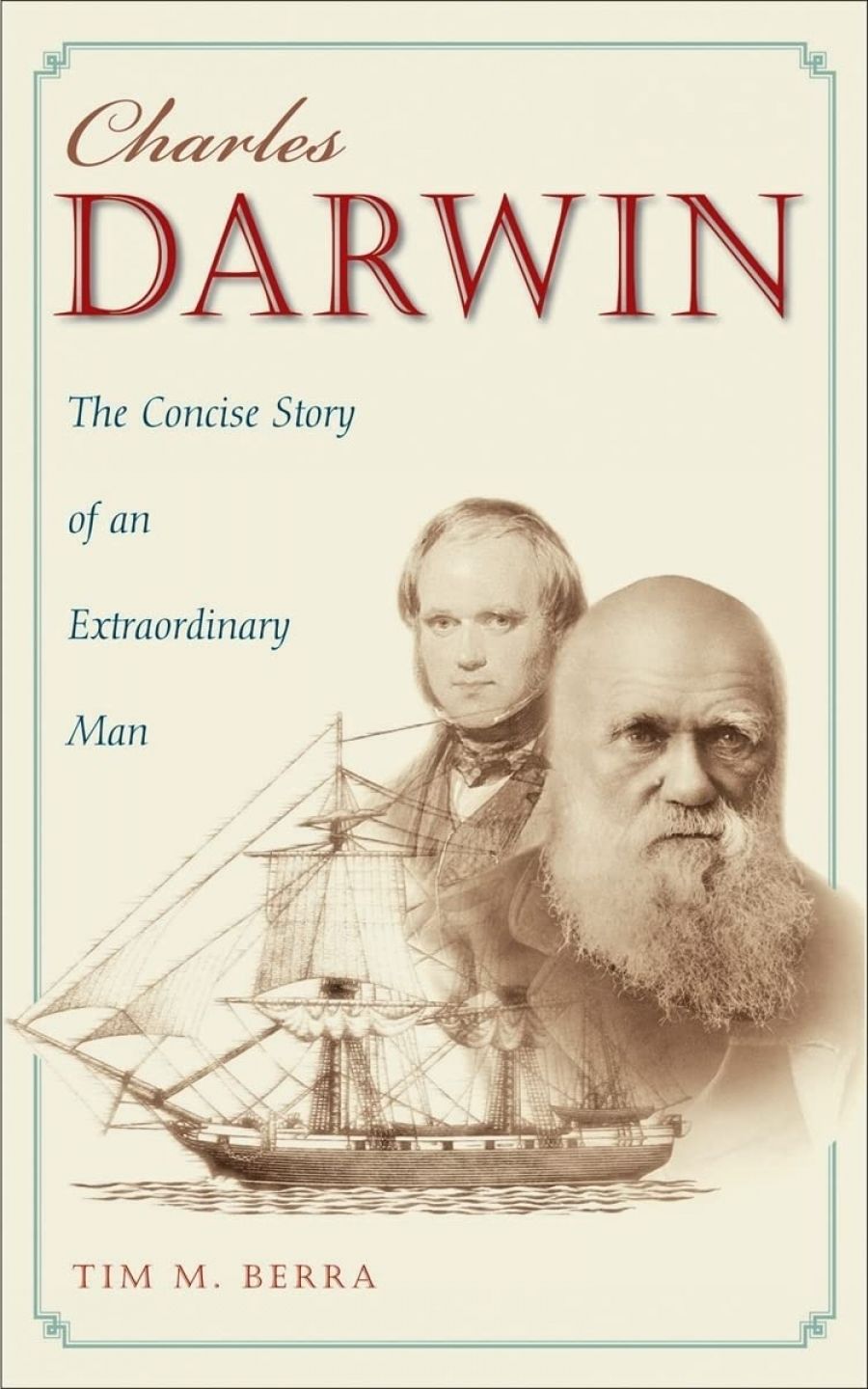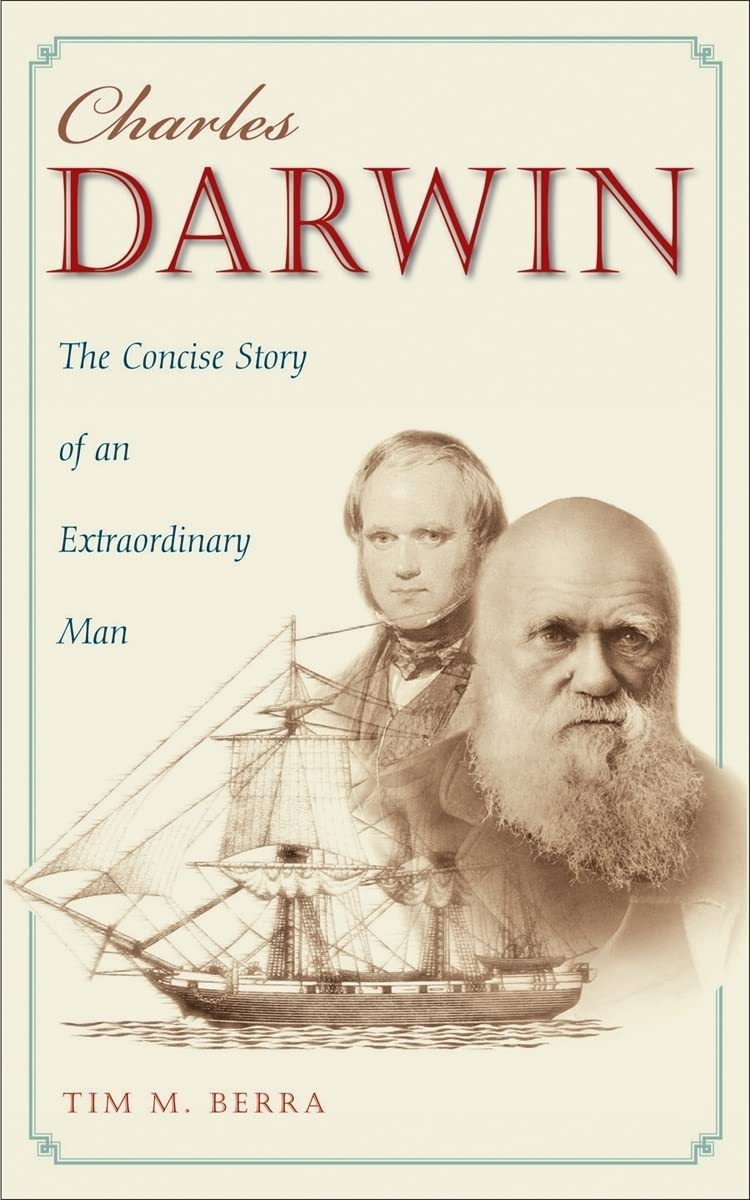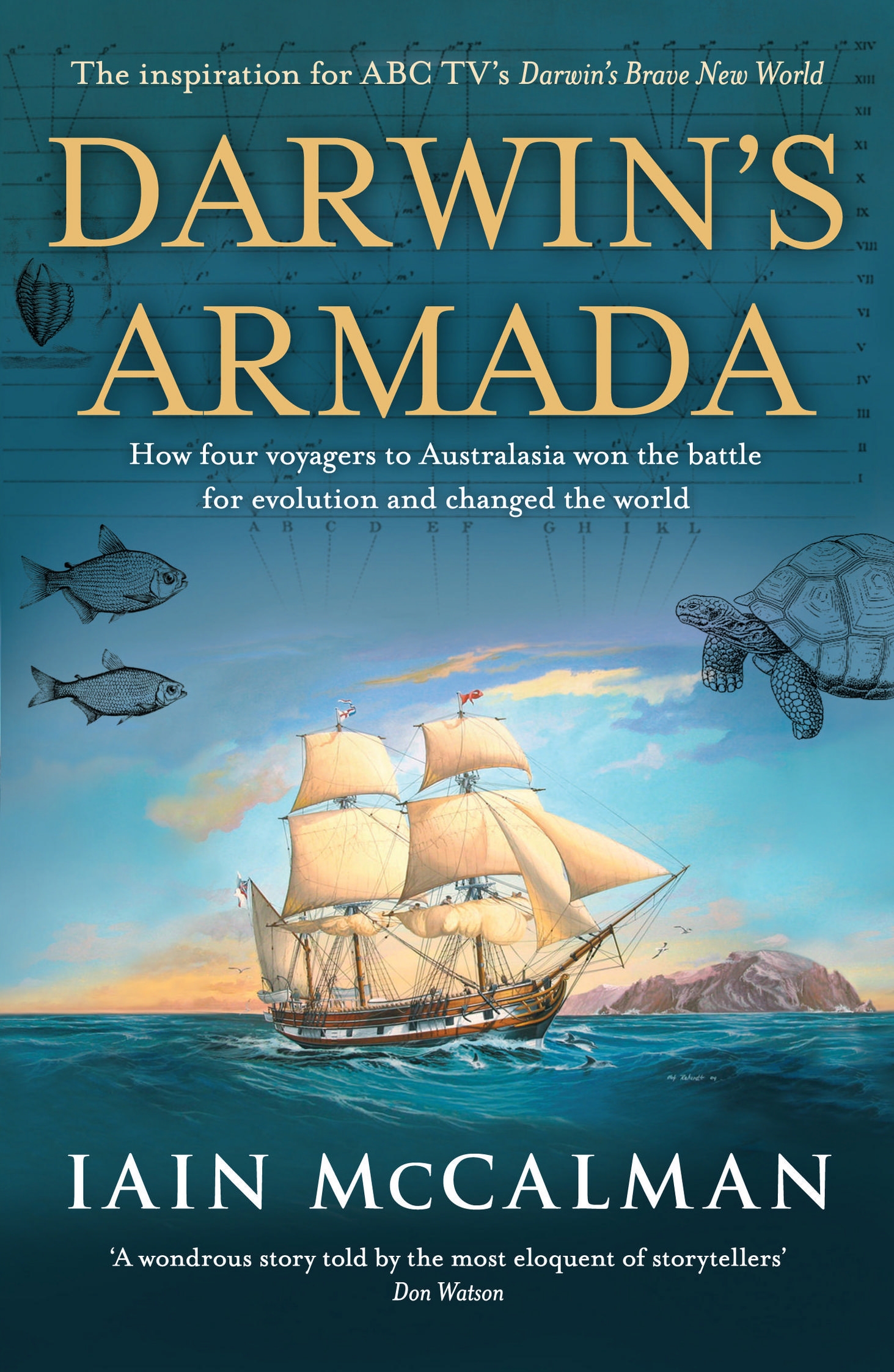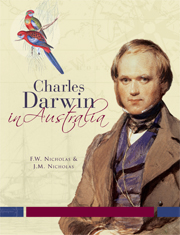
- Free Article: No
- Contents Category: Non-fiction
- Review Article: Yes
- Article Title: Belief’s inertia
- Online Only: No
- Custom Highlight Text:
‘Read monkeys for pre-existence’ wrote the twenty-nine-year-old Darwin in one of his notebooks, pondering Plato’s assertion that our ‘imaginary ideas’ derive from the pre-existence of the soul. Two years earlier, when HMS Beagle had returned from its circumnavigation of the world, Darwin was still a creationist, albeit one who had entertained doubts. Keen to capitalise on his wide-ranging collection, and to make a name for himself, he arranged for various experts to examine the specimens. Fairly quickly during the ensuing discussions, Darwin realised that his doubts concerning the stability of species were ready to burgeon into a new and disturbingly materialist worldview.
- Book 1 Title: Charles Darwin
- Book 1 Subtitle: The concise story of an extraordinary man
- Book 1 Biblio: Johns Hopkins University Press (Footprint Books), $39.95 hb, 114 pp
- Book 1 Cover Small (400 x 600):

- Book 1 Cover (800 x 1200):

- Book 2 Title: Darwin’s Armada
- Book 2 Biblio: Viking, $49.95 pb, 422 pp
- Book 2 Cover Small (400 x 600):

- Book 2 Cover (800 x 1200):

- Book 3 Title: Charles Darwin in Australia, Second Edition
- Book 3 Biblio: CUP, $49.95 hb, 280 pp
- Book 3 Cover Small (400 x 600):

- Book 3 Cover (800 x 1200):

This year is the bicentennial of Darwin’s birth; many books are being published for the occasion. Any biography of Darwin is now done in the shadow of the monumental works by Adrian Desmond and James Moore (1991) and Janet Browne (2002). lain McCalman, in his new book, Darwin’s Armada, broadens the net. Following on from Browne’s emphasis on the vital importance of Darwin’s network of colleagues, McCalman provides short biographies of three of them – Joseph Hooker, Thomas Huxley (coiner of the word ‘agnostic’), and Alfred Wallace – alongside his treatment of Darwin and his work. Some readers will recall the book Darwin and Huxley in Australia (1970), by another Australian professor, Jock Marshall. McCalman’s book, like Marshall’s, is very readable and vividly imagined, but it is altogether broader in scope. The inclusion of Hooker is vital to the coherent telling of the tale.
Browne, Desmond, and Moore condensed their combined two thousand pages of biography into an entry for the Oxford Dictionary of National Biography. In 2007 it was published as a concise pocket-sized book in Oxford’s ‘Very Interesting People’ series. Perhaps the only shortcoming of this small volume was the absence of images or artwork of any kind; Tim Berra’s lighter, generously illustrated and even shorter biography, Charles Darwin: The Concise Story of an Extraordinary Man, fills that gap.
Berra moves quickly through the life, yet finds time to include telling details, as well as sketches of appealing secondary characters. Darwin comes across as an energetic and intelligent boy who loved being outdoors and could not apply himself to a curriculum. At school he was nicknamed ‘Gas’ for his enthusiasm for chemical experiments, but, at fifteen, he exasperated his father by spending every spare minute out hunting (developing skills which would prove vital in his future career). As a medical student in Edinburgh he disliked blood and the suffering of patients, and preferred to spend his time with fishermen, sorting through their nets. He went up to Cambridge, where his passion for beetle collecting intensified. ‘No poet,’ he later recalled, ‘ever felt more delight at seeing his first poem published than I did in seeing in Stephens’ Illustrations of British Insects the magic words “captured by C. Darwin Esq.”.’
Darwin was put in touch with Robert FitzRoy, captain of HMS Beagle, who was looking for a gentleman companion who might be interested in funding his own passage – to the tune of £500 – to pursue scientific interests of his choice. The idea of a scientist paying his passage was not unheard of: two years later, John Herschel paid the same amount to travel to South Africa and complete the survey of the heavens started by his father William Herschel (who has the distinction of being the only astronomer to have also written twenty-four symphonies). Darwin visited Herschel in Cape Town on the Beagle’s return leg.
So Darwin was not the official naturalist on the Beagle, but rather someone who, through his company and conversation, might, during such a long voyage, protect the captain from the psychological dangers of the isolation imposed by rank. As McCalman puts it, Darwin was a ‘human antidepressant’. FitzRoy had cause to be concerned: his predecessor had sunk into a deep depression, locked himself in his cabin, shot himself and taken two weeks to die, eventually succumbing to gangrene in the brain. There was also a family disposition to be worried about: FitzRoy’s uncle, Viscount Castlereagh, had cut his own throat while serving as home secretary.
Darwin’s five-year voyage took him to South America and Australia, and home via Cape Town. He witnessed nature’s immense diversity, and began noticing the importance of geographic separation, as in the distinct vegetation that grew on either side of the Andes. His inland expeditions in South America seem like adventures from the Boy’s Own Paper: quelling a local uprising, camping with bandits, and sneaking through a blockade. In one village, he was attacked by soft black wingless insects that sucked blood. Darwin was plagued by debilitating poor health throughout his life, and one of the many theories is that this attack gave him Chagas disease – both Berra and McCalman mention this in passing. Ralph Colp favours this diagnosis in his detailed account of Darwin’s medical condition, Darwin’s Illness (2009).
The voyage continued to the Galapagos Islands, where Darwin noted the distinct appearance of the tortoises and mockingbirds on the different islands. He also remarked upon the way tortoise meat tasted sweeter on a particular island, which highlights an interesting difference between nineteenth-century naturalists and today’s ecologists. Darwin was later to realise that these islands provided a pivotal experience in the development of his ideas, but at the time his mindset was sufficiently creationist to cause him to partly botch the job of collecting. In particular, he neglected to label from which island the various birds, later all identified as finches, came. In conceiving of his work as cataloguing variations of stable species, he had regarded as immaterial the relatively small geographic separation of the different islands. Back in London, when an expert had identified the birds as all finches, with very marked adaptations (such as in the widely varying shapes of their beaks), Darwin was able to salvage the situation by augmenting his own collection with specimens gathered by three of his shipmates, who – being amateurs and free from conceptual prejudice – had not failed to record from which island the individual birds had come.
Apart from minor slips such as the labelling of the finches, and mistakenly eating a rare bird (a small rhea which he had been hoping to find for months), Darwin was an extraordinary collector, combining a range of hunting skills with superior abilities in description and classification.
The principal purpose of the Beagle’s voyage was a survey of the southern parts of South America, but the secondary purpose was to calculate longitudes of various places as accurately as possible – twenty-two chronometers were used – and to build up a consistent series of measurements. Completing a circumnavigation and returning to the same point (in this case, a town on the coast of Brazil) enabled the accuracy of the calculations to be checked.
After leaving the Galapagos, the Beagle headed for Tahiti, New Zealand, and Australia. It anchored in Sydney Cove on 12 January 1836. Darwin noted the rapid growth of the settlement (‘everyone complains of the high rents & difficulty in procuring a house’): 173 years later, housing affordability is still news. This topical snippet from the diary does not make it into Charles Darwin in Australia, but almost every other piece of source material does: entries from diaries and field books, excerpts from letters, modern photographs of historic sites, and reproductions of maps, sketches, and newspaper cuttings. The book was originally published in 1989, and is now reprinted in a handsome anniversary edition, which takes us step by step through Darwin’s time in Australia. A long postscript section gives details of the subsequent lives of many of the people involved in the story. FitzRoy, for instance, went on to become governor of New Zealand. He was sacked from that post, but was elected to the Royal Society and given the task of running a department newly formed to gather meteorological data. Realising the importance of the barometer in foretelling weather, he invented the weather forecast. In 1865, after two years’ retirement, he slit his throat with a razor.
After a couple of weeks in Australia, Darwin was depressed at the emptiness of Sydney booksellers’ shelves; ‘nothing,’ he wrote, ‘but rather severe necessity should compel me to emigrate’. Fourteen years later, however, he considered moving to Australia, spurred on by widespread concerns that the gold rushes might undermine the British economy, with capital flowing away from the stocks and investments that the Darwin family depended upon.
Darwin’s visit to Australia gave him an important clue to the power of adaptation. He saw species utterly different from their European counterparts, filling similar roles in their environments: the platypus, he said, might easily have been mistaken for a water rat; a kangaroo-rat he likened to a rabbit. He wrote, ‘An unbeliever in everything beyond his own reason might exclaim, “Surely two distinct Creators must have been at work; their object is the same & certainly the end in each case is complete”’, and then considered the remarkable similarities between the Australian antlion and the European species, concluding: ‘Would any two workmen ever hit on so beautiful, so simple, & yet so artificial a contrivance? It cannot be thought so. The one hand has surely worked throughout the universe.’ This is a nice illustration of Darwin’s uncanny knack for finding and pondering puzzles that would lead him towards his theory of natural selection. At the start of the voyage, when he had been daily sifting through the nets he dragged behind the ship, he was struck by the beauty, variety, and volume of the life in the ocean: ‘It creates a feeling of wonder that so much beauty should be apparently created for such little purpose.’
Darwin’s record of the voyage, now known as The Voyage of the Beagle (1839), was an immediate popular success and has never been out of print. Just as Darwin had been inspired by Humboldt’s Personal Narrative (1814–25), a new generation of naturalists, such as the young Joseph Hooker, found a direction for their lives in Darwin’s exciting and evocative account of his travels. Extended voyages through the South Seas were to be an important step in the development of many naturalists at this time: Hooker, Huxley, and Wallace – all key figures in the unfolding story of Darwin’s theories – undertook long sea journeys. McCalman puts forward the notion that it was specifically the shared experience of these South Seas voyages, together with a readiness to form new bonds that is typical of sailors, which enabled Darwin, Hooker, Huxley, and Wallace to join forces in the battle to secure acceptance of Darwin’s ideas. This is an appealing thesis, but it marginalises other figures, such as Asa Gray and John Lubbock, who also played important roles in the story.
Once back in London, Darwin set about arranging the publication of the zoological findings from the voyage and working through his new ideas on the transmutation of species. Amongst all this he made a list of reasons for and against marriage. At around the same age, Franz Kafka was to make a similar list, including items such as ‘I hold all my vigour together’ as an advantage of remaining a bachelor, which seems odd given our notion of Kafka’s vigour. Darwin’s list is altogether more coherent – his reasons against marrying include ‘loss of time’ and ‘less money for books’, but some items are no less surprising than Kafka’s: in the reasons in favour of marrying he includes ‘object to be beloved & played with – better than a dog anyhow’.
Like his father and sister before him, Darwin married into the Wedgwood family. His wife, Emma Wedgwood, was accomplished in her own right; at one time she had piano lessons from Chopin. She was to prove invaluable in helping her husband through his protracted health problems. Assisting in one of his experiments, she played the piano to worms, thus demonstrating that they responded to vibrations. Darwin had typically involved the family in his work; one of his sons had earlier played bassoon to the unreceptive worms. Darwin himself tested the effects of passive smoking on the subjects. Emma wrote to one of their sons that ‘Father ... has taken to training earthworms but does not make much progress as they can neither see nor hear’.
In the space of those first two years after the Beagle’s voyage, Darwin’s ideas came together relatively quickly. However, apart from a couple of brief summaries written up privately, for many years he did nothing directly towards publishing his theory. Partly at Hooker’s instigation, he set to work instead classifying barnacles, working painstakingly to determine the relationships between specimens, and investigating his hypothesis about the descent of species. This task occupied him for eight years. One of his children once asked a friend, ‘Where does your father do his barnacles?’
The story is well known that it was the receipt of a manuscript from Wallace that precipitated Darwin into hurrying into print; Hooker urged him to produce an abstract of his long-planned large work. This 155,000 word ‘abstract’ was The Origin of Species. McCalman draws our attention to a gathering at Darwin’s home which predates the arrival of Wallace’s manuscript by two years, where Darwin presented his ideas to the then sceptical Hooker and Huxley.
Berra manages to summarise Darwin’s theory in a little over a page, and this is possible because the insight is seemingly straightforward: species overproduce young, and the resulting competition for resources leads to the survival of some individuals. This process leads to descent with modification. Even at the time, this struck some as an apparently simple idea: Huxley said, ‘How extremely stupid of me not to have thought of that.’
The process by which certain individuals survive to pass on their favourable traits, Darwin called ‘natural selection’, making an explicit analogy with the ‘artificial selection’ exercised by breeders. This tactic of analogy owes something to Darwin’s admiration for John Herschel’s ideas. Darwin stated that no books influenced him more than Humboldt’s three-volume Personal Narrative and Herschel’s A Preliminary Discourse on the Study of Natural Philosophy (1830). Herschel held up Newton’s analogy of the orbit of planets to the familiar motion of a stone whirled around in a sling as a perfect example of how science should present causes in ways that we can readily understand. We can see the influence of Herschel’s ideas not only in the metaphor of selection but also in the beautifully clear structure of The Origin of Species, where the argument proceeds gradually through examples easily understood by the general reader.
One of the key realisations behind Darwin’s work is that the processes we observe in the present, if applied continually over large periods of time, could produce the effects we see around us. This principle was first developed by geologists and expressed fully by Charles Lyell in his Principles of Geology (1830–1833), which Darwin studied while on the Beagle. It allows us to be scientific about the past by investigating the present. We must make an effort to realise how unimaginable the stretches of ‘deep time’ needed for geological change, or for the transmutation of species, must have seemed to nineteenth-century minds. When Etienne Geoffroy Saint-Hilaire brought back from the Napoleonic expedition to Egypt examples of mummified cats anatomically identical to the modern animal, his protégé and rival Georges Cuvier took this as proof of the stability of species.
Darwin’s last work was his study of the role of worms in forming the soil. Darwin saw, with what amounts to visionary insight, that the very shape of the low rolling hills of the English landscape is the result of millions of years of the action of worms passing small particles through their body, transforming them into finer particles, and displacing soil as they go. In 1982 Stephen Jay Gould selected this last work to discuss in commemoration of the centenary of Darwin’s death.
Darwin, aged seventy-three, died shortly after a heart attack. He and his family had wanted a simple ceremony at the village church, but Huxley had successfully agitated for a large public event. Although he was never knighted, Darwin’s funeral was held in Westminster Abbey; the pallbearers included Hooker, Huxley, Lubbock, and Wallace. Darwin was laid to rest near Isaac Newton, and next to John Herschel, although he would have preferred to lie in his local graveyard, along with two of his children and his older brother, where, as Stephen Jay Gould observed, he could have been processed into the landscape he loved by the action of the worms he had so thoroughly investigated.


Comments powered by CComment